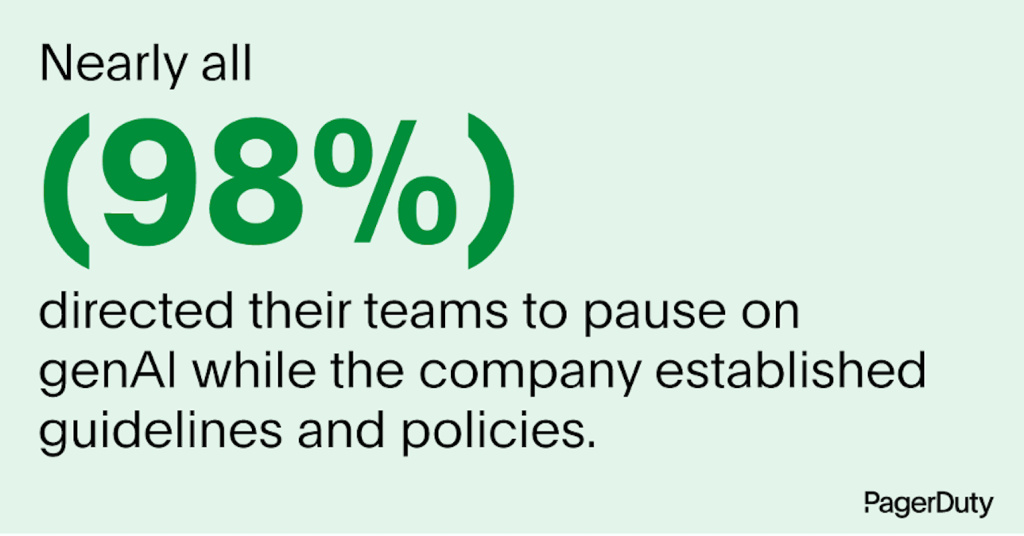In the corner office, fear of GenAI risk outweighs the lure of its promise

I find listening to and learning from leading global CEOs, board members, and technology executives in our customer base incredibly fulfilling. We discussed their business goals, growth ambitions, and the challenges they face to modernize their operations.
Chances are, we’ll talk about their fears too. That’s because, with the fast-paced evolution and imminent adoption of generative AI, the role of CIOs and CTOs has become both exciting and invigorating, but also more complicated and unpredictable.
What is clear in each of these conversations is the increasing necessity to operate responsibly, safely, and reliably to protect their customers’ experiences. This sense of mission is why I joined PagerDuty as CEO almost eight years ago.
The reality is, both people and software are imperfect. Seemingly benign conditions collude to cause sudden, high-impact business disasters, which we all experience as consumers more frequently. Whether an IT glitch grounded the flight you were relying on, interrupted the stream of a live sporting event you subscribed to, or made it impossible to access your trading account, these issues likely led to your dissatisfaction. You potentially ended your relationship with the brand, and certainly, the company that let you down suffered financial consequences.
The risk of material business incidents is increasing. And it’s not because tech teams are not undertaking their best efforts to avoid them, but rather because the tech debt is piling up in every industry, manifesting in increasing complexity and widespread fragility. The major incidents you read about in the news — this is tech debt coming to call.
IT and operations teams are on the front lines of any major incident that interrupts the normal course of business. And while incident management was never for the faint of heart, CIOs, and CTOs are actually losing sleep en masse.
Normally early adopters of new technology, tech execs now are holding back on launching major generative AI initiatives until they are assured guardrails are in place. The unpredictability of AI outcomes and mistrust of technology that iterates on its own comes amid rising expectations from Wall Street to Main Street to monetize technology investments and deliver seamless experiences.
I’ve been hearing about this collective anxiety in private conversations for months. Beneath the bluster of all things AI, leaders are centering on the conundrum of accelerating innovation while designing risk management frameworks for threats we cannot entirely predict but must anticipate. No longer can teams get away with simply responding faster. Prevention is the best medicine.
Increasingly our customers turn to PagerDuty’s Operations Cloud for relief. We help them anticipate and manage the unpredictable nature of major incidents — predicting them, detecting them, resolving them, and learning from them so they don’t happen again. Through AI-centered automation, our solutions deliver clear value to help companies grow revenue, create efficiency, and mitigate risk. That’s why more than half of the Fortune 500 and nearly 70 percent of the Fortune 100 use PagerDuty.
Recently, in an effort to better understand CIOs’ attitudes around generative AI, we conducted a survey with Wakefield Research of 100 Fortune 1000 executives including CIOs and IT leaders. The findings were indicative of a population that feels concerned and conflicted about the new technology while trying their best to lead their organizations into the next era in a measured and thoughtful way.
When asked, these executives told us they have a deep distrust of generative AI, especially the security risks and ethical concerns associated with them. Specifically, we heard:
- Every one of them — 100% of executives surveyed — have concerns about the security risks of generative AI technology, and nearly all (98%) have paused their generative AI initiatives to establish policies.
- All of them — 100% — believe that human intervention is essential to successfully implement generative AI, yet the extent of human involvement varies as 73% think it requires a moderate amount, and 23% believe only a low level is needed.
- More than half (51%) believe they should adopt generative AI only after they have the right guidelines in place, and only 29% have those guidelines in place; and,
- A full quarter revealed they do not trust generative AI, full stop.
Despite serious reservations, these executives feel strong competitive pressures to act speedily. Nearly half (46%) of those surveyed believe they risk falling behind if they don’t adopt generative AI as quickly as possible.
As I mentioned six months ago, many technology leaders feel caught between FOMO and FOGI — the “fear of missing out” on the benefits of innovation versus the “fear of getting in” without the right safeguards, jeopardizing reliability and customer trust.
Much has changed in the 16 months since the public release of ChatGPT in November 2022. Management teams and Boards are rethinking every part of their business strategies. Public markets are rewarding sector pioneers and infrastructure players. Labor markets reveal that workers are concerned about their future employability. And educational institutions are struggling to prove their relevance in a time of transition.
Certainly, generative AI is a game changer for business, society, and humanity. I have personally experienced it to be a net positive. But no great reward comes without risk.
As business leaders, it’s our role to anticipate and mitigate risks in service to our customers and competitive advantage. If people who are managing technology for the world’s biggest companies are holding off on generative AI adoption, they will miss out on the upside that will widen the competitive gap. But rushing in hastily is irresponsible.
There’s another path: I contend it’s better to meet the risks head on. When you anticipate them, you can position your business to manage the unexpected in an unpredictable world. This means being intentional in setting guidelines for use, implementing systematic guardrails, and importantly investing now in operational resiliency. In this way, when you experience major incidents, you are prepared, equipped with the best platforms to limit the blast radius and its impact, and empowered to get back quickly to the work at hand — innovation in service of your customers.
PagerDuty

PagerDuty
To learn more, visit us here.



